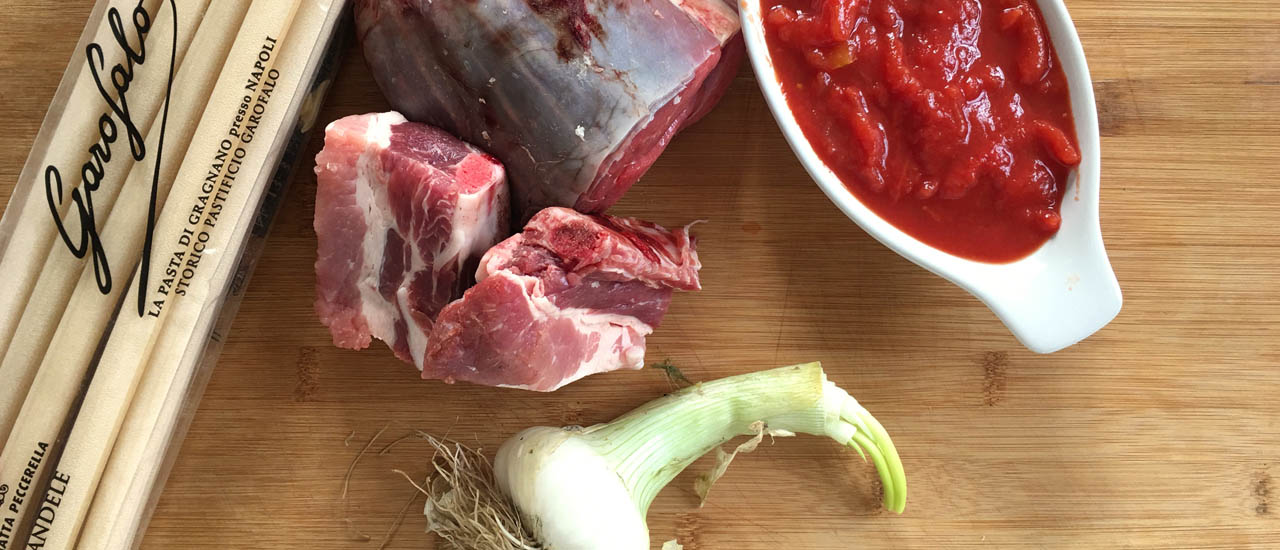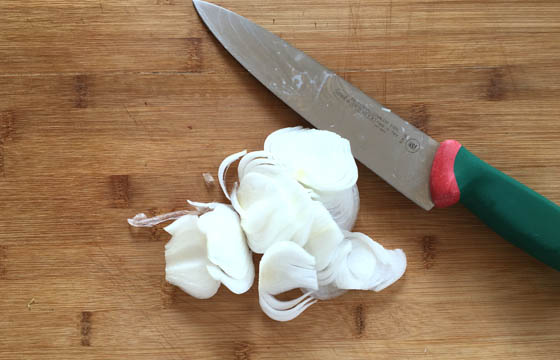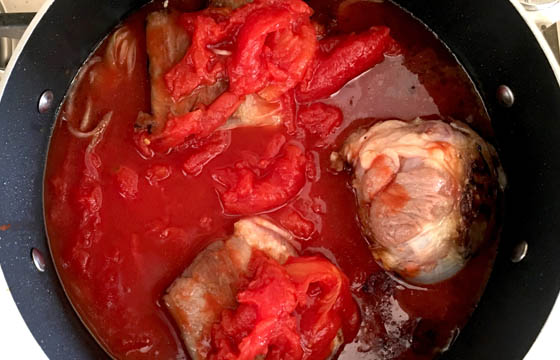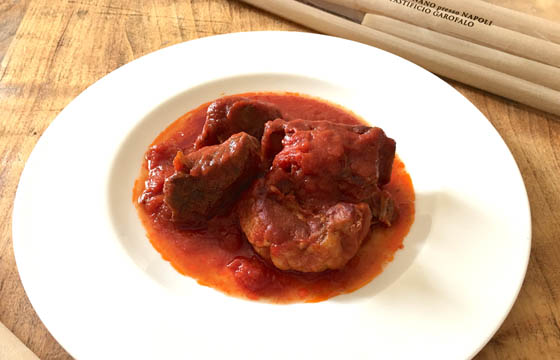Ingredients
 17.50 oz of beef muscle
17.50 oz of beef muscle 17.50 oz of pork muscle
17.50 oz of pork muscle 8.80 oz of pork ribs
8.80 oz of pork ribs olive oil
olive oil red wine to taste
red wine to taste 1 or 2 tablespoons of tomato concentrate
1 or 2 tablespoons of tomato concentrate 7 oz of tomato sauce
7 oz of tomato sauce 1.75 oz of onions
1.75 oz of onions

Now, here is a story that is part legend and part truth. As with many Neapolitan dialectal words, the etymology of the term is French. But we want to tell another story about ragù: the same story that has been told, every Sunday, since 1300. So, it starts with the smell of onions browning in oil, spreading up the staircases of buildings. The meat sizzles a bit; children hear the noise while still half asleep in their beds on a day off. The aluminum pan whispers and pants for five or six hours. Ravenous kids roam around the stove like little eagles, looking for slices of bread to dip in the sauce, careful not to get caught by their mothers, who would scold them affectionately. The men are already seated at the kitchen table, breaking the candele or ziti (types of pasta), with expert hands. The smallest bits are placed in a bowl: they will be the best part of the dish. The end of this story is the happiest, and it comes when everyone is around a noisy table, the tomato sauce is almost black and the meat is as tender as butter. Ragù is our story, a Neapolitan story, universal yet unique, a custom which is repeated every Sunday wherever a Neapolitan is present. Ragù it is not just a dish, it’s a way of living, waiting, tasting, and remembering. ’O rraù ca me piace a me m’ ‘o ffaceva sulo mammà. A che m’aggio spusato a te, ne parlammo pè ne parlà. Io nun songo difficultuso; ma luvàmmel’ ’a miezo st’uso Sì, va buono: comme vuò tu. Mò ce avéssem’ appiccecà? Tu che dice? Chest’è rraù? E io m’ ’o mmagno pè m’ ’o mangià... M’ ’a faje dicere ’na parola?... Chesta è carne c’ ’a pummarola. The ragout I really like, Is the one only my mother made. Since I married you, we talk about it, just to have something to talk about. I don’t want to be difficult; But let’s drop this habit. Yes, all right, as you wish. We don’t want to squabble about it now, do we? So, what are you saying? That this is “ragout”? Now, I will eat it, just for the sake of eating. Will you just let me say something?... this is meat with tomatoes. Eduardo De Filippo
 17.50 oz of beef muscle
17.50 oz of beef muscle 17.50 oz of pork muscle
17.50 oz of pork muscle 8.80 oz of pork ribs
8.80 oz of pork ribs olive oil
olive oil red wine to taste
red wine to taste 1 or 2 tablespoons of tomato concentrate
1 or 2 tablespoons of tomato concentrate 7 oz of tomato sauce
7 oz of tomato sauce 1.75 oz of onions
1.75 oz of onions

Most sources report, regarding the traditional Neapolitan Ragu, the “lardellata” (lard) as first phase, which means putting ham, bacon, and pepper inside the meat, before stringing it. Most modern Neapolitans don’t do it, Ragu being already pretty heavy by itself, given the long cooking time. In the same way, according to old sources, the first phase of cooking should last two hours, without tomato. Tradition would also require the use of a copper or clay pan (the so-called tiano).

Cut the onions into julienne strips, brown them in oil, taking care not to burn them.

Add the meat and let it roast on all sides to close the pores. Add some red wine in two times and let it evaporate. This phase should last around 40 minutes.

At this point, add the tomato concentrate and let it melt in oil. Then, add the tomato sauce raising the heat, with some water. As soon as it comes to boil, lower the heat to the minimum and let it simmer. During this phase, the pan should be covered with a lid, but not completely. You can put a wooden spoon or another long tool between the pan and the lid to create a little opening.

This phase will last from a minimum of four hours, to a maximum of six. Every once in a while, check if the meat has become tender. If it is ready, you can remove it from the sauce (some pieces require a shorter cooking time) so it doesn’t melt, and then re-add it at the end. The ragout will be ready when the tomato sauce is thick, dark, and shiny in appearance.